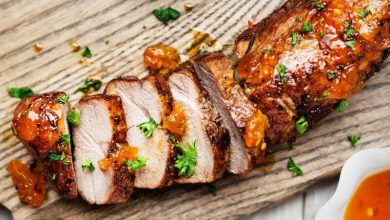🍽️ Asian Pork Roast: A Delicious Culinary Adventure 🍖
Ah, the delectable Asian Pork Roast! 🤤 This dish is a flavorful and mouthwatering masterpiece that blends savory and sweet flavors, creating a taste sensation that’s truly delightful. Let’s dive into its history, components, preparation steps, and the time it takes to create this culinary delight! 🌟
📜 History:
The Asian Pork Roast is a fusion of various Asian culinary traditions, primarily influenced by Chinese and Southeast Asian flavors. It’s a testament to the rich tapestry of Asian cuisine, which has evolved over centuries. The exact origins are challenging to trace, but it has become a popular dish in many Asian households and restaurants worldwide.
🥘 Components:
- Pork: The star of the show! You can use a pork loin, tenderloin, or even pork belly for a richer flavor.
- Marinade: This typically includes a combination of soy sauce, hoisin sauce, garlic, ginger, honey, and sometimes five-spice powder for that authentic Asian twist.
- Vegetables: Many recipes call for vegetables like carrots, onions, and bell peppers to complement the dish.
- Sauce: A rich, aromatic sauce made from the marinade and pork juices.
👨🍳 Preparation Steps:
-
Marinate the Pork: Begin by mixing your marinade ingredients. Rub this flavorful concoction over your pork, ensuring it’s well-coated. Let it marinate in the fridge for at least a couple of hours or, even better, overnight.
-
Preheat the Oven: When you’re ready to cook, preheat your oven to 350°F (175°C).
-
Sear the Pork: Heat some oil in an ovenproof skillet or a roasting pan. Sear the marinated pork on all sides until it’s golden brown. This helps seal in the juices.
-
Add Vegetables: Toss in your chopped vegetables around the pork. These will absorb the flavorful juices as they cook.
-
Roast: Place the pan in the preheated oven and roast for about 25-30 minutes per pound of pork. Use a meat thermometer to ensure it reaches an internal temperature of 145°F (63°C) for safe consumption.
-
Rest and Slice: Once done, remove the pork from the oven, cover it with foil, and let it rest for about 10-15 minutes. This allows the juices to redistribute, keeping the meat tender and succulent.
-
Prepare the Sauce: While the pork is resting, you can prepare a sauce using the drippings and some additional marinade if desired. Heat it in a pan, let it simmer, and thicken slightly.
-
Slice and Serve: Slice the pork into medallions and serve it with the roasted vegetables and a drizzle of the delicious sauce.
🕒 Time Needed:
The preparation time for Asian Pork Roast can vary, but it’s typically around 15 minutes to prepare the marinade and marinate the pork, plus additional time for marinating (a few hours to overnight). The roasting itself takes roughly 25-30 minutes per pound of pork. Including rest time, you can expect the entire process to take about 2-3 hours.
🍽️ Your patience and effort will be rewarded with a dish that’s bursting with flavor, tender, and absolutely scrumptious! Enjoy your Asian Pork Roast adventure! 🥢👌😋
🍽️ Nutrition Facts and Health Information for Asian Pork Roast 🍖
Here’s the nutrition information and some health considerations for Asian Pork Roast:
📊 Nutrition Facts (Approximate values per 4-ounce serving of cooked pork loin):
- Calories: About 190-220 calories
- Protein: 25-30 grams
- Total Fat: 8-10 grams
- Saturated Fat: 2-3 grams
- Unsaturated Fat: 5-7 grams
- Cholesterol: 60-70 milligrams
- Sodium: 400-500 milligrams (varies based on marinade ingredients)
- Carbohydrates: 3-5 grams
- Fiber: 0 grams
- Sugars: 3-5 grams
- Vitamins and Minerals: The dish is a good source of various B vitamins, particularly niacin (B3), and provides essential minerals like selenium, phosphorus, and zinc.
🌟 Health Information:
-
Protein: Pork is a great source of high-quality protein, which is essential for muscle growth and repair.
-
Fats: While pork does contain fat, it’s essential to choose lean cuts and trim excess fat to make the dish healthier. The fats in pork can include monounsaturated and polyunsaturated fats, which are heart-healthy.
-
Sodium: Be cautious with the amount of sodium in the dish, especially if you’re using soy sauce or other high-sodium ingredients. High sodium intake can contribute to high blood pressure, so consider low-sodium alternatives.
-
Sugars: The sugar content mainly comes from ingredients like honey and hoisin sauce. While they add delicious flavors, be mindful if you’re watching your sugar intake.
-
Vitamins and Minerals: Pork is a good source of various nutrients, particularly B vitamins like niacin, which supports energy metabolism, and minerals like selenium, which acts as an antioxidant.
-
Vegetables: The vegetables in the dish contribute fiber, vitamins, and minerals, enhancing the overall nutritional value.
Remember that the exact nutritional content can vary depending on factors like the specific cut of pork, the marinade ingredients, and the portion size. Adjusting the recipe to use lean cuts of pork, reducing added sugars and sodium, and incorporating a variety of colorful vegetables can make your Asian Pork Roast a healthier choice while preserving its delicious flavors.




